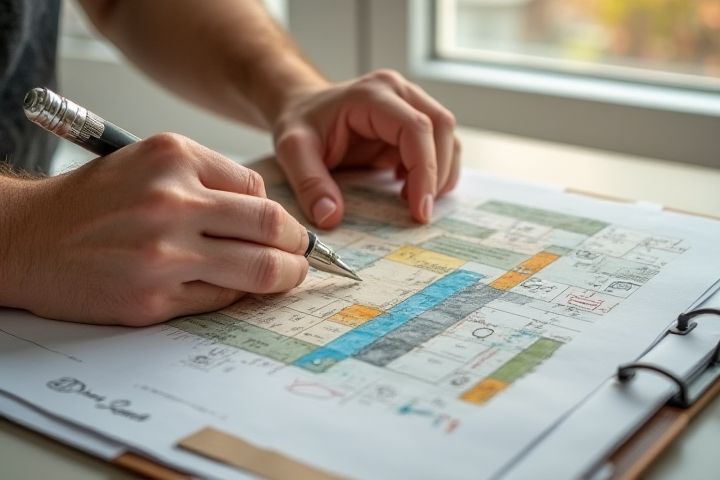
Begin your home renovation by establishing a clear vision and budget. Assess the condition of your property to identify necessary repairs, focusing on structural integrity and safety features like electrical systems and plumbing. Create a prioritized list of projects, ranging from essential upgrades to aesthetic enhancements, ensuring each aligns with your goals. Research local regulations and obtain required permits to avoid legal complications during the renovation process. You should also consider hiring professionals for complex tasks, such as roofing or foundational work, to ensure quality and efficiency.
Where To Start When Renovating A House
Set a clear budget
Setting a clear budget is crucial when renovating your house, as it establishes financial boundaries and helps prioritize projects. Begin by assessing the total funds available, including savings, loans, or potential financing options, to understand your financial landscape. Break down your budget into specific categories, such as structural repairs, interior design, and landscaping, ensuring you allocate enough for unexpected costs that may arise during the renovation process. By maintaining a detailed budget, you can make informed decisions, avoid overspending, and keep your renovation project on track.
Assess the property's condition
Assessing the property's condition is crucial before diving into your renovation project. Start by inspecting the roof, plumbing, electrical systems, and foundation for any signs of wear or damage, as these aspects can significantly impact renovation costs. You may also want to evaluate the overall layout and design to identify potential improvements or adjustments to better suit your needs. Hiring a professional home inspector can provide you with a comprehensive report, often costing between $300 to $500, ensuring you're aware of any major issues before moving forward.
Prioritize renovation tasks
Identify essential areas of your home, such as the kitchen and bathrooms, as these renovations often yield the highest return on investment, sometimes exceeding 70%. Conduct a thorough assessment of structural issues, like roof repairs or foundation stabilization, which should be prioritized to ensure safety and longevity. Next, allocate your budget effectively, typically starting with 10%-15% for unexpected expenses. Finally, create a timeline, breaking down tasks into manageable phases, enabling you to see progress and keep your renovation organized.
Hire professional contractors
Hiring professional contractors is a crucial first step when renovating a house. Skilled contractors bring expertise in their respective trades, ensuring quality workmanship and adherence to local building codes. Research shows that homes renovated by licensed professionals not only increase in value but also experience fewer maintenance issues down the line. You should obtain multiple quotes, verify licenses, and check references to find a contractor who aligns with your vision and budget.
Obtain necessary permits
Obtaining necessary permits is a crucial first step in your house renovation project, as it ensures that all work complies with local building codes and regulations. Depending on your location, you may need permits for structural changes, plumbing, electrical work, or even aesthetic modifications like adding new windows or altering exterior facades. Research your local municipality's requirements, which may include submitting plans and paying application fees that typically range from $50 to several hundred dollars. Skipping this step can lead to costly fines or delays, so securing the right permits will help protect your investment and streamline the renovation process.
Create a realistic timeline
Creating a realistic timeline for your house renovation is essential for a successful project. Begin by assessing the scope of work, breaking it down into phases such as design, demolition, construction, and finishing touches. Allocate time for each phase, keeping in mind potential delays caused by permits, weather, or supply chain issues; typically, a complete renovation can take anywhere from a few months to over a year. Regularly review and adjust your timeline based on progress, ensuring you stay on track and within budget.
Focus on structural improvements
Begin your renovation by assessing the foundation, as it is crucial for the overall stability of your home. Inspect for cracks or shifting that may indicate deeper issues, and consider investing around $5,000 to $10,000 in repairs if necessary. Next, evaluate the roof for leaks or damage, which can cost between $7,000 and $15,000 to replace, protecting your home from water damage in the future. Finally, check for load-bearing walls, as reinforcing these may require professional assistance, often priced at $1,000 to $3,000 depending on the complexity of the project.
Update plumbing and electrical systems
Begin your renovation by updating plumbing and electrical systems, as these are critical for ensuring safety and functionality in your home. Assess the existing infrastructure, checking the age of pipes and wiring; for example, homes built before 1978 may have outdated components that require replacement. Prioritize installing modern fixtures and energy-efficient lighting to improve efficiency and potentially lower your utility bills by 20% or more. Engaging licensed professionals for these upgrades can help guarantee compliance with local building codes and enhance the overall value of your property.
Choose quality materials
When renovating a house, selecting quality materials is crucial for ensuring longevity and aesthetic appeal. For instance, investing in high-grade hardwood for flooring can increase the lifespan of your floors significantly, often lasting over 30 years compared to cheaper alternatives. Consider using energy-efficient windows and doors, which can not only enhance your home's comfort but also reduce energy bills by up to 30%. You should prioritize sustainable options, like reclaimed wood or low-VOC paints, to create a healthier living environment and add unique character to your home.
Plan for unexpected issues
When renovating a house, it's crucial to budget at least 10-20% of your total renovation costs for unexpected issues. This buffer accounts for potential surprises, such as hidden structural damage or outdated electrical systems. Prioritize a comprehensive inspection to identify potential problem areas before demolition begins, enabling you to adjust your plan accordingly. Document every step of your renovation process, ensuring that you have the flexibility to adapt while staying within your revised budget.
